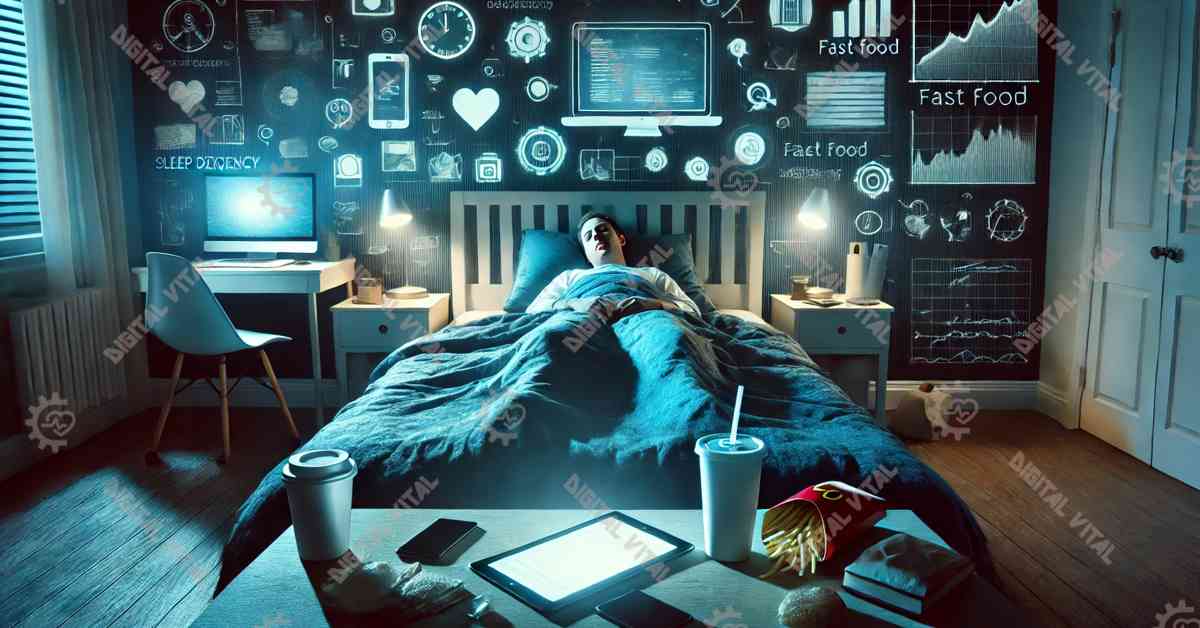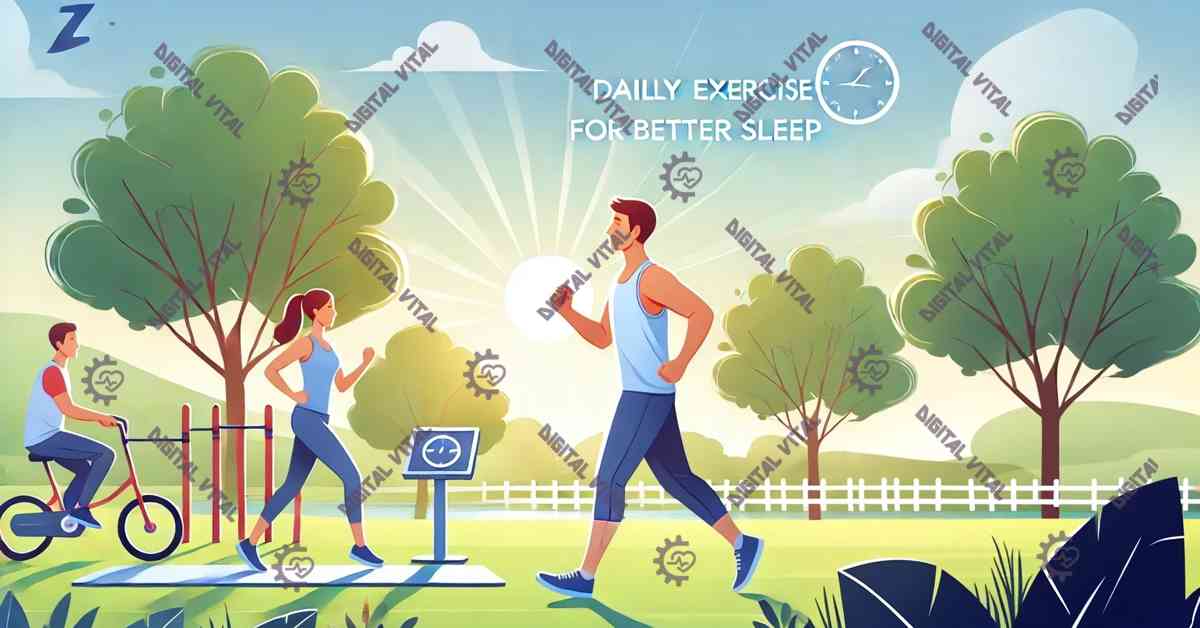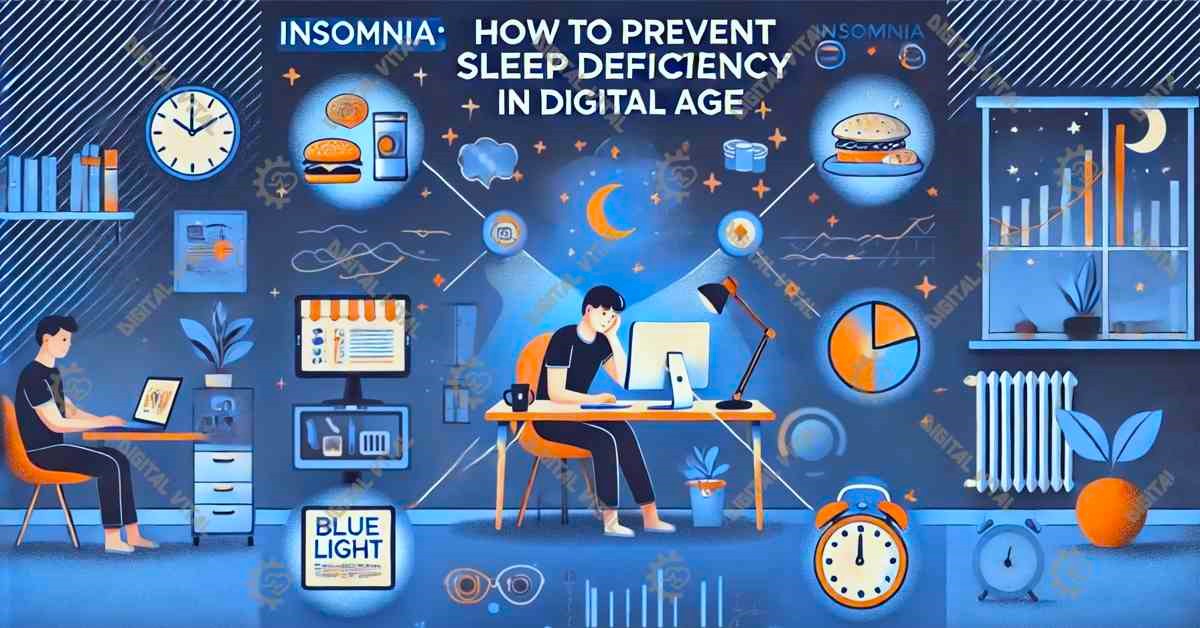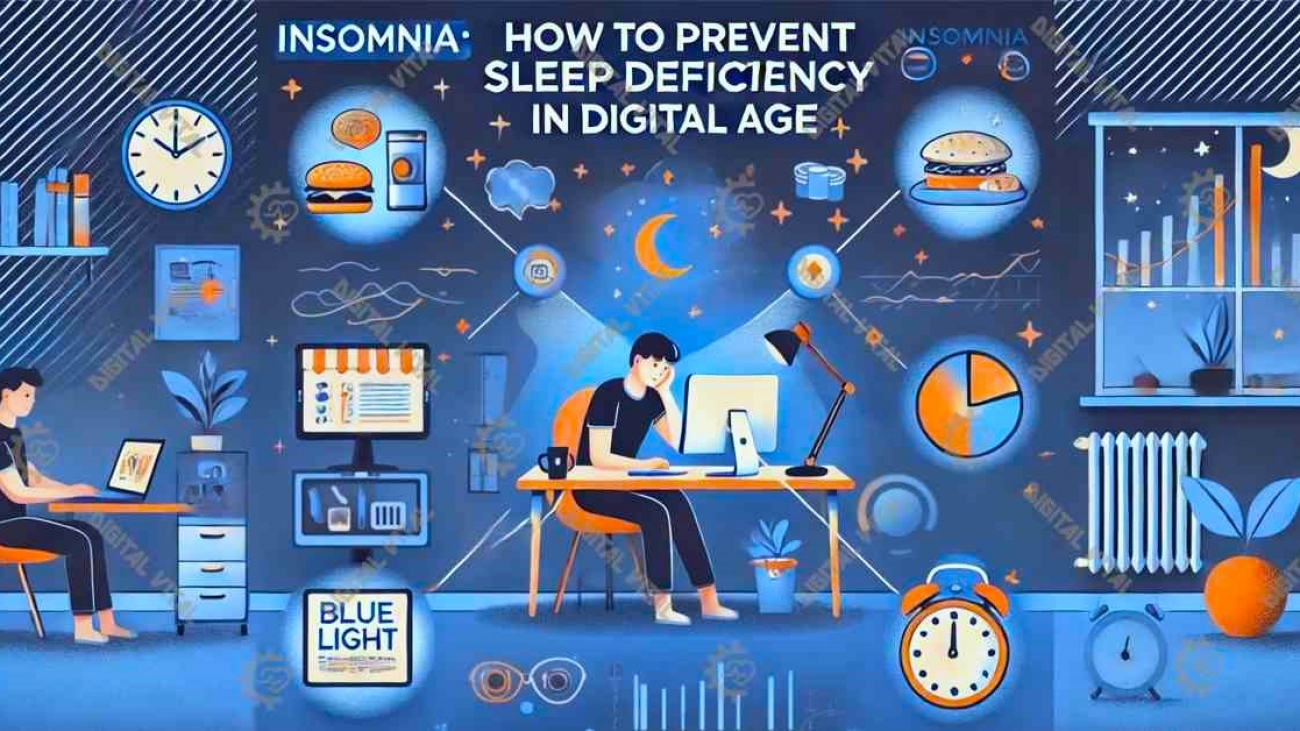Abstract
Insomnia, a pervasive issue in today’s digital age, is exacerbated by the increasing use of electronic devices such as mobile phones, tablets, and laptops. The overexposure to blue light emitted by these devices significantly disrupts sleep patterns. Additionally, modern lifestyle factors such as prolonged sitting, insufficient physical exercise, and poor diet habits influenced by industrialization and fast food culture contribute heavily to sleep deficiency. This article explores various research findings on the subject and offers practical solutions for achieving better sleep and improved health.
Table of Contents
Understanding Insomnia in the Digital Age
The digital age has brought unprecedented convenience and connectivity, but it has also introduced significant challenges to our health, particularly sleep. Insomnia, characterized by difficulty in falling asleep, staying asleep, or waking up too early, affects millions of people worldwide. The relentless use of electronic devices is a primary culprit. These devices emit blue light, a high-energy visible light that interferes with the body’s natural sleep-wake cycle.
The Impact of Blue Light
Blue light exposure in the evening can suppress the production of melatonin, the hormone responsible for regulating sleep. According to a study by Harvard Medical School, blue light exposure two hours before bedtime can significantly delay sleep onset and reduce sleep quality . Another study published in the Journal of Clinical Endocrinology & Metabolism found that blue light exposure in the evening can alter circadian rhythms, making it difficult for individuals to fall asleep at their usual time .
Sedentary Lifestyle and Sleep Deficiency
The modern sedentary lifestyle further exacerbates sleep deficiency. Prolonged sitting and lack of physical exercise contribute to poor sleep quality. A study conducted by the American Heart Association highlights the connection between physical inactivity and sleep disorders, noting that regular physical activity can improve sleep patterns and overall health . Engaging in moderate aerobic exercise, such as walking or cycling, can help reduce the time it takes to fall asleep and increase the duration of sleep.
Poor Diet and Its Role in Sleep
Diet plays a crucial role in sleep health. The rise of fast food culture and poor dietary habits have led to an increase in sleep disorders. Foods high in sugar and saturated fats can disrupt sleep by causing fluctuations in blood sugar levels and stimulating the central nervous system. Research from the National Institutes of Health indicates that a diet rich in fruits, vegetables, and whole grains is associated with better sleep quality . Consuming foods high in tryptophan, magnesium, and melatonin, such as nuts, seeds, and dairy products, can also promote restful sleep.

Research: Interplay between Technology use and Sleep Disorders
Research on the interplay between technology use and sleep disorders has provided substantial evidence of how our digital habits contribute to insomnia. A comprehensive study published in Sleep Medicine Reviews conducted a meta-analysis of multiple investigations into pre-sleep technology use. The study found a consistent correlation between the use of electronic devices before bedtime and increased sleep latency, which is the time it takes to transition from full wakefulness to sleep. Participants who engaged with devices like smartphones, tablets, and laptops reported poorer sleep efficiency and a reduced overall sleep duration.
The interactive nature of these devices, such as texting, browsing social media, and gaming, was shown to stimulate mental activity and delay the onset of sleep. This cognitive stimulation can keep the brain active, making it difficult for individuals to wind down and achieve restful sleep. The findings suggest that even passive activities, such as watching videos or reading on a screen, can negatively impact sleep quality if done too close to bedtime.
Further emphasizing the detrimental effects of technology on sleep, a study by the University of California, Berkeley, explored how screen time affects sleep hygiene and sleep deficiency. Researchers discovered that individuals with high pre-sleep technology use experienced significant disruptions in their circadian rhythms.
This disruption was particularly pronounced with blue light exposure, which interferes with the production of melatonin, the hormone that regulates sleep-wake cycles. The study underscored that even a brief exposure to blue light from electronic screens could shift circadian rhythms, causing delays in sleep onset and reducing sleep quality. The findings recommended practical health solutions such as implementing a digital curfew and promoting activities that prepare the body for sleep, which can help mitigate these adverse effects.
A groundbreaking investigation by the National Institutes of Health (NIH) provided further insight into how dietary habits compounded by technology use contribute to sleep deficiency. The NIH study highlighted that the modern fast-food diet, rich in sugars and unhealthy fats, exacerbates the problem of insomnia. Poor dietary choices, when combined with sedentary behavior and extensive screen time, create a perfect storm for sleep disorders. The NIH research indicated that individuals who consumed healthier diets, including foods rich in tryptophan, magnesium, and other sleep-promoting nutrients, experienced fewer sleep disturbances. These findings advocate for a holistic approach to better sleep that includes not only limiting technology use but also making informed dietary choices and engaging in regular physical activity.
Overall, these research findings paint a clear picture of how deeply intertwined our technology use, lifestyle choices, and dietary habits are with our sleep health. By addressing these factors collectively, significant improvements in sleep quality and overall well-being can be achieved. Implementing health solutions that promote better sleep, such as reducing evening screen time, fostering a balanced diet, and increasing physical activity, is essential for combating the epidemic of insomnia in the digital age.

Solutions for Better Sleep
Improving sleep quality in the digital age requires a multifaceted approach. Here are some practical solutions:
Limiting Blue Light Exposure
To mitigate the effects of blue light on insomnia, it is essential to limit screen time in the evening. Blue light, emitted by smartphones, tablets, and laptops, can significantly disrupt the body’s production of melatonin, making it difficult to fall asleep. One effective health solution is to establish a digital curfew at least one hour before bedtime. This practice involves turning off all electronic devices and engaging in activities that promote relaxation, such as reading a physical book, listening to calming music, or practicing meditation.
In addition to setting a digital curfew, using blue light filters on devices can help reduce exposure. Many smartphones and computers have built-in features that shift the display colors to warmer tones during evening hours. Alternatively, blue light-blocking glasses can be worn to filter out the harmful blue wavelengths. Research has shown that these glasses can improve sleep quality and reduce sleep deficiency by allowing the body’s natural circadian rhythms to function more effectively. By taking these steps, individuals can create an environment conducive to better sleep and reduce the negative impact of digital devices on their health.
Enhancing Physical Activity
Incorporating regular physical activity into daily routines can significantly improve sleep quality and combat insomnia. Physical exercise helps regulate the body’s internal clock, or circadian rhythm, promoting more consistent sleep patterns. Engaging in moderate aerobic exercise, such as walking, cycling, or swimming, can reduce the time it takes to fall asleep and increase the duration and quality of sleep. Studies have shown that individuals who exercise regularly experience deeper, more restorative sleep compared to those who lead a sedentary lifestyle.
However, timing and type of exercise are crucial for achieving better sleep. It is advisable to complete vigorous workouts earlier in the day, as exercising too close to bedtime can have a stimulating effect and delay sleep onset. Incorporating activities like yoga and stretching into the evening routine can be particularly beneficial. These exercises not only enhance physical health but also promote relaxation and stress reduction, which are essential for overcoming insomnia. By making physical activity a regular part of the daily routine, individuals can address sleep deficiency and enhance their overall well-being.

Adopting a Healthy Diet
Diet plays a crucial role in promoting better sleep and combating insomnia. Consuming a balanced diet rich in nutrients can significantly impact sleep quality. Foods high in sugar and saturated fats can cause fluctuations in blood sugar levels and stimulate the central nervous system, leading to sleep disturbances. On the other hand, a diet that includes plenty of fruits, vegetables, whole grains, and lean proteins can support better sleep health. Nutrient-rich foods such as nuts, seeds, dairy products, and leafy greens contain sleep-promoting compounds like tryptophan, magnesium, and melatonin.
Avoiding heavy meals, caffeine, and alcohol close to bedtime is another important aspect of a sleep-friendly diet. These substances can interfere with the ability to fall asleep and stay asleep. Instead, opt for light snacks that promote sleep, such as a banana or a glass of warm milk, which contain nutrients that support relaxation and sleep onset. Staying hydrated throughout the day but reducing fluid intake in the evening can also help prevent nighttime awakenings. By making mindful dietary choices, individuals can address sleep deficiency and promote overall health.

Creating a Sleep-Conducive Environment
Transforming the bedroom into a sleep-friendly environment is essential promoting better sleep. The bedroom should be a sanctuary dedicated to rest and relaxation. This includes maintaining a cool, dark, and quiet room, which helps signal to the body that it is time to sleep. Using blackout curtains, earplugs, and white noise machines can minimize disruptions from external light and noise. Additionally, investing in comfortable bedding and a supportive mattress can make a significant difference in sleep quality.
Eliminating electronic devices from the bedroom is another critical step. The presence of smartphones, tablets, and televisions can be distracting and emit blue light that interferes with sleep. Creating a bedtime routine that includes relaxation techniques such as meditation, deep breathing, and gentle stretching can also prepare the mind and body for sleep. These practices help reduce stress and anxiety, which are common contributors to insomnia. By fostering a sleep-conducive environment and establishing a consistent bedtime routine, individuals can improve sleep quality and address sleep deficiency effectively.
Conclusion
In the digital age, addressing insomnia and promoting better sleep requires a comprehensive approach that includes limiting blue light exposure, enhancing physical activity, adopting a healthy diet, and creating a sleep-conducive environment. By implementing these health solutions, individuals can significantly improve their sleep quality and overall well-being. It is crucial to recognize the interconnected nature of technology use, lifestyle habits, and dietary choices in combating sleep deficiency. Through mindful adjustments and consistent practices, better sleep and improved health can be achieved.
For personalized guidance and support in overcoming insomnia and enhancing your sleep quality, consider booking a consultation or session with our experts. Visit Digital Vital Services to learn more and start your journey towards better sleep and improved health today.

References
- Harvard Medical School. (2012). Blue light has a dark side. Retrieved from Harvard Health Publishing
- Chang, A. M., Aeschbach, D., Duffy, J. F., & Czeisler, C. A. (2015). Evening use of light-emitting eReaders negatively affects sleep, circadian timing, and next-morning alertness. Proceedings of the National Academy of Sciences, 112(4), 1232-1237.
- American Heart Association. (2019). Physical Activity Improves Quality of Life. Retrieved from American Heart Association
- National Institutes of Health. (2017). Diet and Sleep: What Foods Help or Harm Your Sleep? Retrieved from NIH
- Hale, L., & Guan, S. (2015). Screen time and sleep among school-aged children and adolescents: A systematic literature review. Sleep Medicine Reviews, 21, 50-58.
- University of California, Berkeley. (2019). Digital devices and insomnia: The role of sleep hygiene. Retrieved from UC Berkeley
- National Sleep Foundation. (2020). Physical Activity and Sleep. Retrieved from National Sleep Foundation
- Chang, A. M., & Czeisler, C. A. (2019). The impact of light on sleep and circadian rhythms. Neuroscience & Biobehavioral Reviews, 98, 96-107.
- Kripke, D. F., Langer, R. D., & Elliott, J. A. (2017). Melatonin and its possible role in insomnia treatment. Journal of Sleep Research, 26(2), 128-138.
- Buysse, D. J., Reynolds, C. F., Monk, T. H., Berman, S. R., & Kupfer, D. J. (1989). The Pittsburgh Sleep Quality Index: A new instrument for psychiatric practice and research. Psychiatry Research, 28(2), 193-213.

